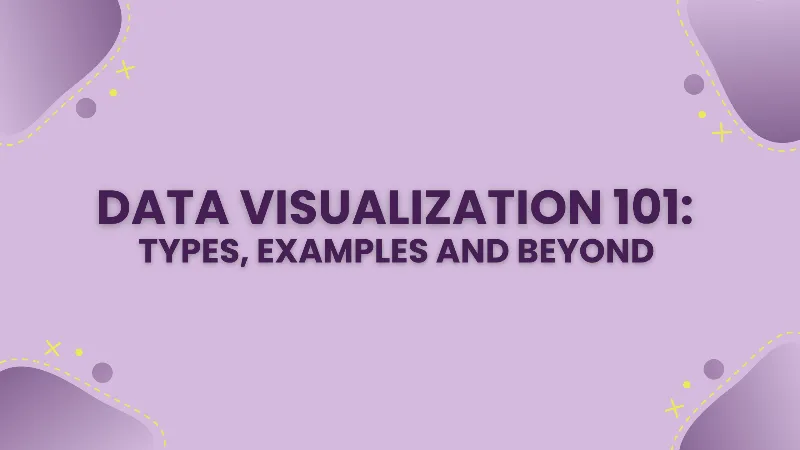Data Visualization 101 - Types, Examples and Beyond

Check out OLake, our latest open source offering for replicating databases to lakehouses.
Imagine this: You have a dataset with more rows than there are grains of sand on a beach. It's a tangled mess that could make Einstein scratch his head. But fear not because, with the magic of data visualization, we'll transform that chaos into breathtaking art.
Let's dive into a real-life example: imagine you're analyzing global temperature trends. Instead of staring at rows and columns of temperature data, we'll whisk you away on a visual journey. Picture a captivating line chart that takes you through the ups and downs of Earth's temperature over the past century.
The rising and falling lines become a roller coaster ride, with peaks and valleys that tell the story of our changing climate. Suddenly, you're not just looking at numbers but experiencing the impact firsthand.
In this blog, we'll unveil the secrets of creating stunning visual representations that unlock hidden insights and make complex information easy to grasp. We'll explore various visualization techniques, from captivating charts to interactive maps, and show you how they can transform your data into a captivating narrative.
So get ready to unleash the full potential of your data, captivate your audience, and gain a deeper understanding of the world around us. So buckle up and join us on this exciting adventure into the realm of data visualization!
What is Data Visualization?
Data visualization is the art and science of representing data in a visual format, such as charts, graphs, maps, or infographics. It is a powerful tool that allows us to understand complex information, patterns, and relationships by presenting them visually, intuitively, and engagingly.
How ChatGPT Has Affected The World Of Marketing
Why is Data Visualization Important?
Data visualization is crucial for several reasons:
Understanding Trends and Patterns
Data visualizations help us spot trends, patterns, and relationships that raw data may not reveal. Visualizing data helps us identify upward or downward trends, seasonality, and anomalies, which aids decision-making, planning, and problem-solving.
Simplified Understanding of Complex Data
Complex datasets are difficult to understand. Data visualization turns data into charts, graphs, and diagrams. This simplification makes data understanding and insight extraction easier for everyone.
Data-driven storytelling
Visualizations can tell interesting stories. We can tell compelling stories using data and compelling visuals. Data-driven storytelling makes insights, emotions, and stakeholders more memorable and actionable.
In summary, data visualization is essential because it leverages our natural visual processing capabilities to enhance understanding, support decision-making, facilitate communication, and uncover valuable insights within data.
It plays a vital role in making data more accessible, meaningful, and actionable for individuals and organizations across various domains.
Types of Data Visualization
There are several common types of data visualization techniques used to represent and communicate information visually. Some of the main types include:

Bar charts
Bar charts are popular. Each bar's length or height shows its measurement. Bar charts compare categories.

When to use
- Use bar charts to compare and contrast different categories or groups. They are suitable for displaying discrete data or showing the distribution of a categorical variable.
When to avoid
- Avoid using bar charts when the data categories are too numerous, or the values are too close together, making it difficult to distinguish and compare them accurately.
- Avoid using stacked bar charts when it is important to compare the individual values of each category, as the stacked format can make it challenging to perceive individual contributions.
Line charts
Line charts show trends over time or a continuous variable. Time series and variable relationships are present.

When to use
- Choose line charts to visualize trends or patterns over time or across a continuous variable. They are ideal for representing time series data or illustrating the relationship between variables.
When to avoid
- Avoid using line charts when the data points are sporadic, irregular, or lack a clear trend over time or across the x-axis. In such cases, alternative chart types like scatter plots or area charts might be more appropriate.
- Avoid using line charts when there are significant gaps or missing data points, as the lines may suggest a continuous trend that does not accurately represent the data.
Pie charts
Each slice represents a percentage. They display categorical variable composition and size.

When to use
- Use pie charts to show the composition or distribution of a categorical variable. They are effective for displaying proportions or percentages and comparing the relative sizes of different categories.
When to avoid
- Avoid using pie charts when you have too many categories, as it can be challenging to accurately interpret and compare minor differences in slice sizes.
- Avoid using pie charts to compare proportions that are close in value, as it can be difficult to distinguish and accurately perceive minor differences.
Scatter plots
Scatter plots use Cartesian coordinates to graph data points as dots. The relationship between two numerical variables helps identify data clusters and correlations.

When to use
- Choose scatter plots when you want to examine the relationship between two numerical variables. They are useful for identifying data correlations, clusters, or outliers.
When to avoid
- Avoid using scatter plots when the data points are highly concentrated or overlapping, making it difficult to discern individual points and patterns.
- Avoid using scatter plots when the variables being compared do not have a clear relationship or correlation, as the absence of a meaningful relationship may lead to misinterpretation.
Maps
Maps show spatial data well. They use symbols, colors, or shading to depict geographic locations, borders, densities, and patterns.

When to use
- Use maps to represent geographical or spatial data. They are excellent for illustrating locations, boundaries, densities, or patterns across a specific geographic area.
You can Nurture both Leads and Customers - True or False?
When to avoid
- Avoid using maps when the geographical aspect is irrelevant or meaningful to the presented data. In such cases, alternative visualization methods may be more appropriate.
- Avoid using maps when the data does not have a clear geographical component, as it may introduce unnecessary complexity and distract from the key insights.
These are just a few examples of how data can be visualized. The choice of visualization technique depends on the nature of the data, the intended audience, and the specific insights or patterns you want to convey.
How to Choose the Correct Data Visualization Type?
The easiest and the most fool-proof way of selecting the correct type of data representation involves the following criteria:

Once you follow these criteria and select the visualization type accordingly, your representation will be pitch-perfect.
Case studies
Several companies have successfully leveraged data visualization to gain insights and make data-driven decisions. Here are a few notable examples:
The New York Times - Olympic Races Visualization
The New York Times used an interactive line chart to visualize the results of Olympic races. The line chart showcased the performance of athletes over time, allowing users to explore trends and compare athletes' performances across different events.
NASA - Earth Observing System Data Visualization
NASA utilized satellite data to create visualizations through maps and 3D models to monitor and understand Earth's climate, weather patterns, and natural phenomena. These visualizations helped scientists and policymakers gain insights into global environmental changes.
Airbnb - Neighborhood Analysis Visualization
Airbnb developed a map visualization to help users explore neighborhoods and understand the distribution of available listings. This visualization allowed users to compare prices, reviews, and amenities across different neighborhoods, aiding in the decision-making process for potential guests.
Johns Hopkins University - COVID-19 Dashboard
Johns Hopkins University created an interactive dashboard to track and visualize the global COVID-19 pandemic. The dashboard utilized various visualizations, including line charts, bar charts, maps, and scatter plots, to display real-time data on infection rates, deaths, recoveries, and vaccination progress.
Spotify - Music Recommendation Visualizations
Spotify used data visualizations, such as scatter plots and heatmaps, to analyze music attributes and user listening behavior. These visualizations allowed Spotify to recommend personalized playlists and discover new songs that align with users' musical preferences.
These case studies demonstrate the versatility of data visualization techniques across different domains.
For example, line charts were used to show trends over time, maps displayed geographical information, scatter plots helped identify patterns and relationships, and interactive visualizations empowered users to explore and analyze data meaningfully.
The choice of visualization type depends on the nature of the data, the insights being conveyed, and the user's interaction requirements.

Conclusion
In conclusion, data visualization is a powerful tool that enables us to present complex data in a visual format, making it easier to understand and extract insights. We can effectively communicate trends, comparisons, proportions, and relationships within the data by choosing suitable chart types and visualizations.
Avoiding misleading visualizations and considering the suitability of the selected visualization method is essential for accurate representation. Many successful companies have utilized data visualization to drive their growth and make data-driven decisions.
Real-world case studies across various domains demonstrate the impact and effectiveness of data visualization in providing valuable insights and enhancing decision-making processes.
Embracing data visualization can empower organizations and individuals to derive meaningful insights from data and unlock new opportunities for success.
